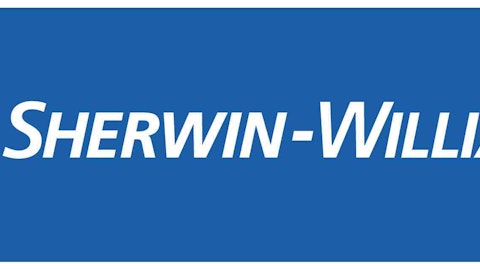Management has created substantial value for shareholders, but can the company’s next decade of life come close to matching its last? The bar has certainly been set high.
The company’s next goal is to hit 5,000 stores in North America, which would be about a 25% increase from where the company ended 2014. Management insists this is not the end goal but rather a milestone along the way of SHW’s long-term growth path.
Given the high level of fragmentation in the paint market, we believe SHW will have opportunities to continue its expansion, but the company is likely much closer to a saturation point (at least in the U.S.) than it was 10 years ago. As we mentioned earlier, SHW’s store count is already substantially higher than Home Depot, Lowe’s, and PPG, and its stores are close to almost all of the country’s population.
Sherwin-Williams Co (NYSE:SHW) has also invested in Latin America for international volume growth and continues expanding its product offering through R&D, acquisitions, and organic distribution growth (e.g. its first-ever architectural paint program in Lowe’s stores nationwide under the HGTV HOME by Sherwin-Williams label rolled out over the last year).
We think SHW’s growth outlook looks good over the next 3-5 years, but we are less sure beyond then due to the company’s relatively large store base and geographical concentration in the U.S. market.
Sherwin-Williams’ Key Risks
As we alluded to above, we believe the biggest risk to SHW’s long-term future is market saturation in the U.S. The company has significantly more stores than its next largest peers and a strong presence in most regions already.
Investors appear to be giving management the benefit of the doubt given the stock’s current earnings multiple (20x). If SHW finds fewer opportunities for profitable store growth than it currently expects, the stock will be in trouble. The company also has less exposure to faster-growing international markets, so it is especially dependent on U.S. growth opportunities.
Additionally, SHW’s market seemingly has few barriers to entry – no one can stop Home Depot or other competitors from building new stores in a location and pressuring prices – but the company’s brands, reputation, and specialization (controlled channel model) help mitigate risk from new competition.
Finally, the state of the housing market and trends in raw material costs (e.g. oil-based materials and titanium dioxide) could impact SHW’s business results over the near-term, but we don’t expect either issue to impair the company’s long-term outlook. As seen below, the U.S. architectural coatings industry is still seeing volumes recover from the housing crisis.

Source: Sherwin-Williams Investor Presentation
Dividend Analysis: Sherwin-Williams
We analyze 25+ years of dividend data and 10+ years of fundamental data to understand the safety and growth prospects of a dividend. SHW’s long-term dividend and fundamental data charts can all be seen by clicking here.
Dividend Safety Score
Our Safety Score answers the question, “Is the current dividend payment safe?” We look at factors such as current and historical EPS and FCF payout ratios, debt levels, free cash flow generation, industry cyclicality, ROIC trends, and more. Scores of 50 are average, 75 or higher is very good, and 25 or lower is considered weak.
SHW’s Dividend Safety Score of 96 suggests that the company’s dividend payment is safer than 97% of all other dividend-paying stocks in the market. As seen below, SHW’s payout ratios have remained low and steady over the last decade, providing plenty of cushion and room for growth. Even if SHW’s earnings cut in half, its payout ratio would only increase to around 50%.

Source: Simply Safe Dividends

Source: Simply Safe Dividends



